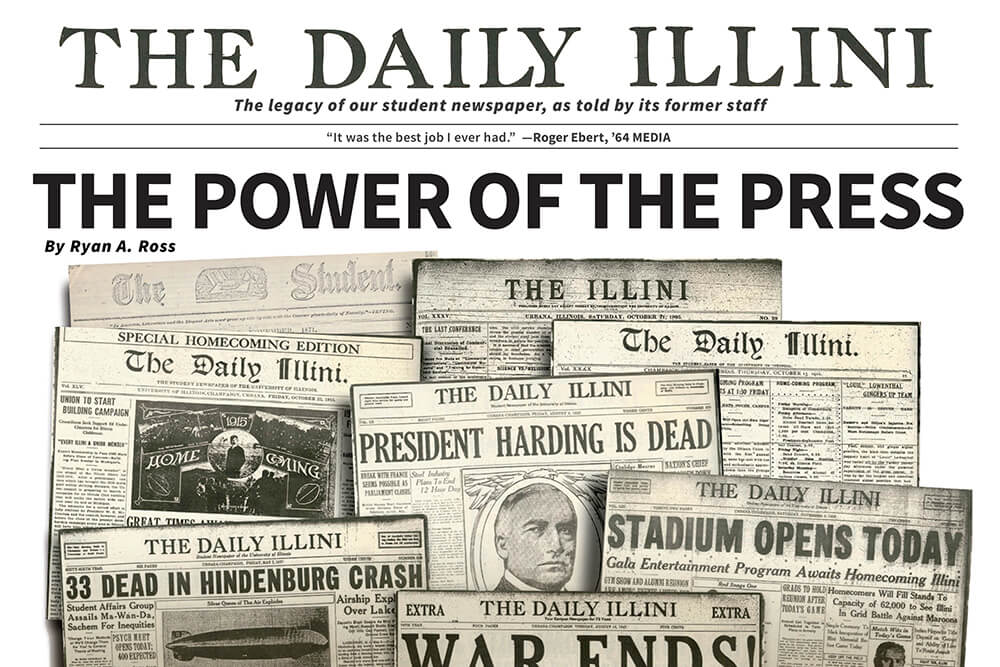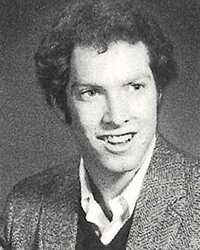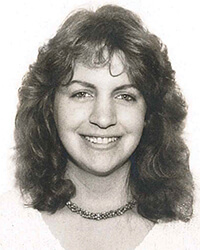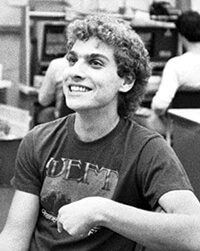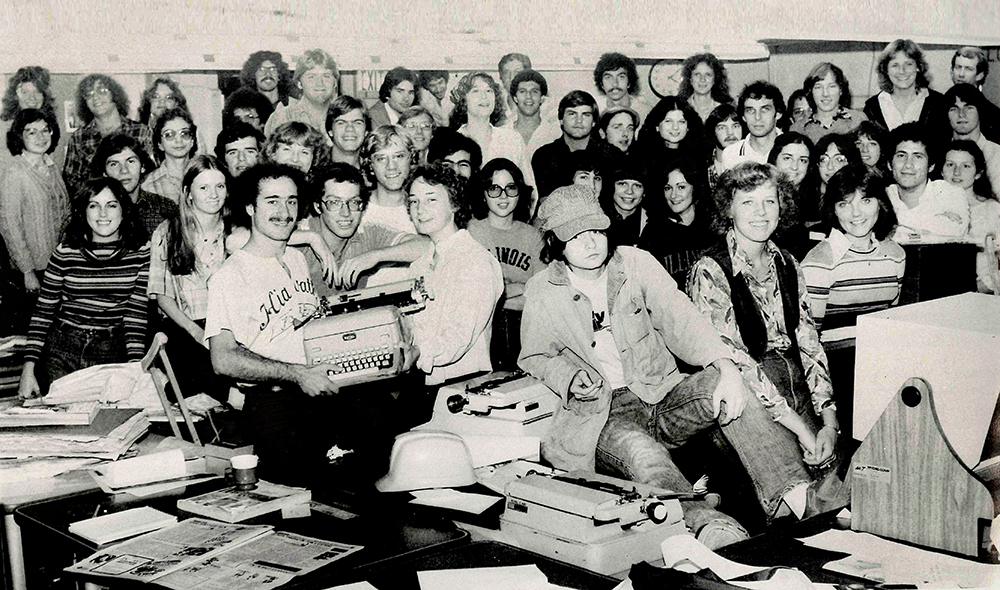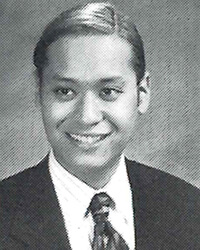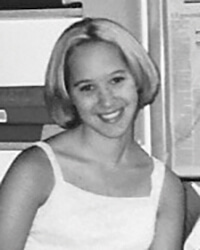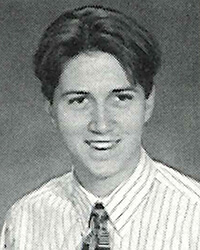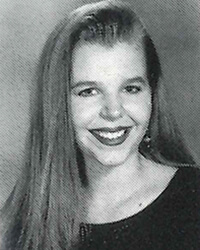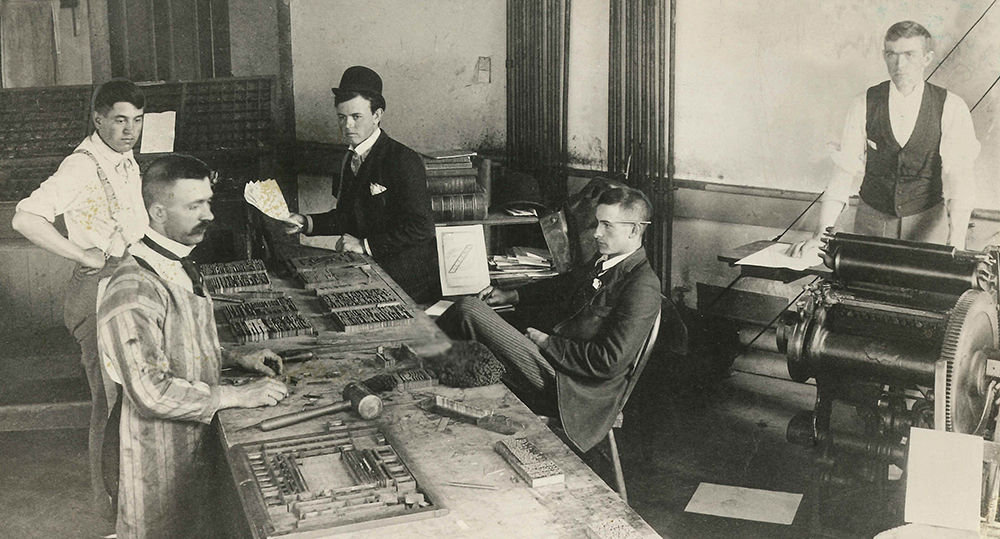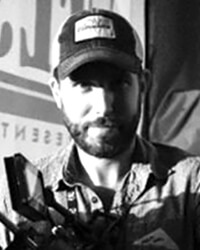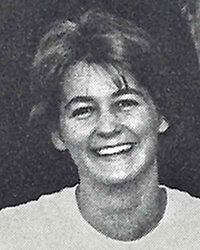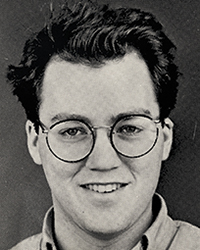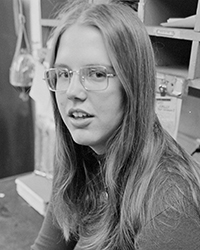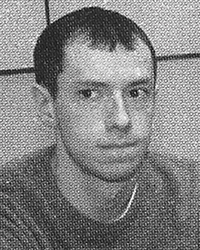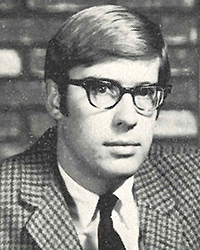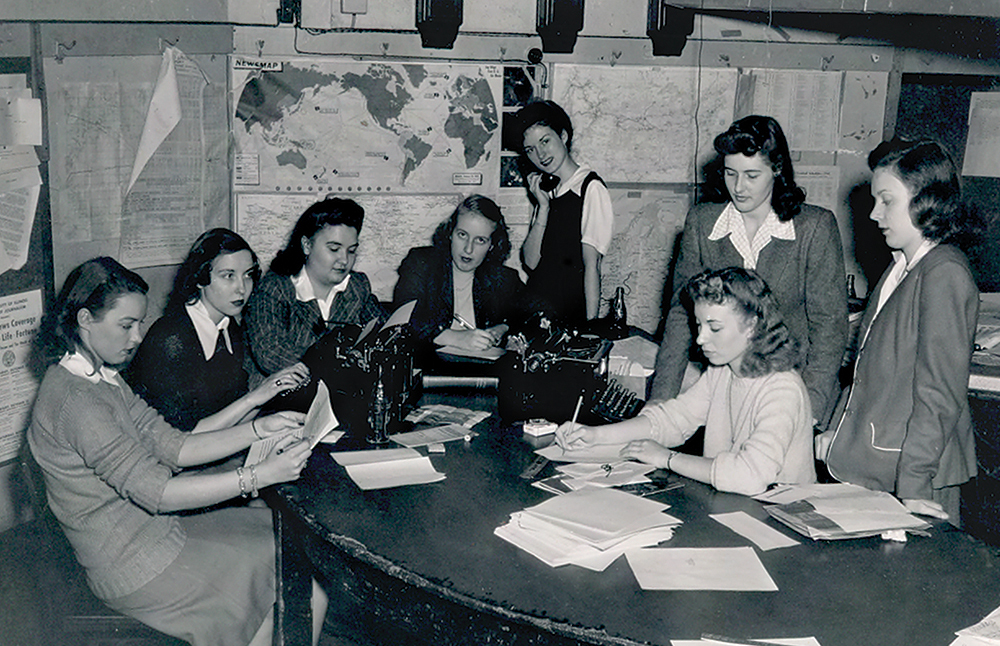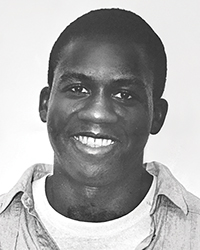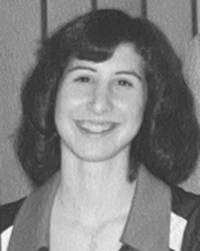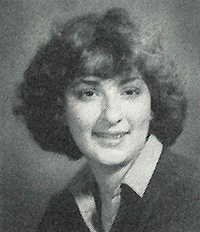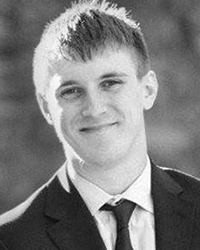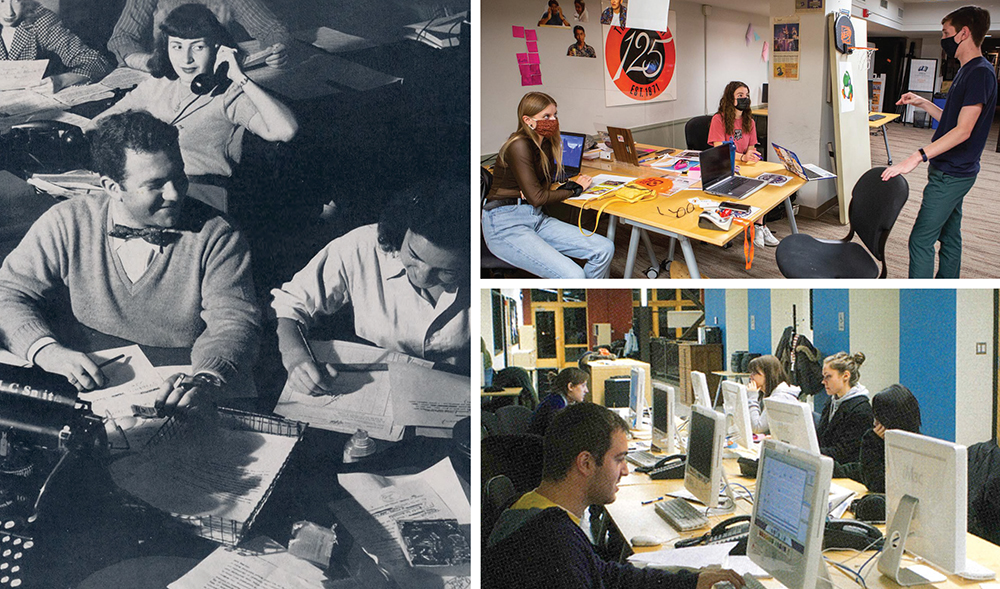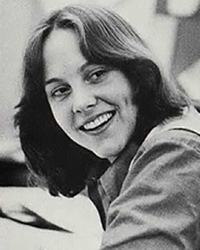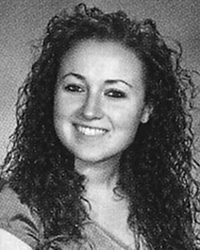Training Ground
The Daily Illini was the first student newspaper to become a member of the Associated Press and, for much of the 20th century, was regarded as the best college paper in the U.S. Its alumni have won 14 Pulitzer Prizes and a legion of other awards, and gone on to leadership positions in the nation’s top newsrooms, from The New York Times and The Washington Post to NPR and ABC.
In the pages that follow, DI alumni share their memories of the paper and the impact it has made—and continues to make—in their lives, and in the world at large.
What’s Your Major?
Whenever someone asks, “What was your major at Illinois?” I always say I majored in Daily Illini. The classes were great, but I believe journalism is a craft where you learn by doing, and the 50-hour-plus weeks working at The Daily Illini taught me how to become a journalist. The paper gave me the opportunity to do everything from sending the sports section to the presses at midnight to covering Illinois football.
During my senior year, I got to cover the Illinois basketball team playing in the NIT in New York City. I mean, for a 20-year-old with big dreams, it is hard to beat writing game stories for the first time at Madison Square Garden. It also says a lot about The Daily Illini’s commitment to coverage back then. They sent me to New York for four days. Today, major newspapers don’t send reporters across the street.
Whenever I reflect on the most important day in my life, I always go back to my second day on campus, when I walked into Illini Hall for the first time and asked to join the sports staff. That first day and the next four years at The Daily Illini laid the foundation for all that I achieved in my career as a journalist. —Ed Sherman, ’81 MEDIA, 27-year sportswriter, Chicago Tribune
Daily Grind
It was a little intimidating at first to work for The Daily Illini. It was an entrenched, established, respected, student-run, independent, working-world newspaper, with a storied history—Roger Ebert, Hugh Hefner, Roger Simon, Marcia Kramer, Dan Balz, Bill Nack, Paul Ingrassia, Godfrey Sperling, John Strohm…. What does a wide-eyed sophomore from the suburbs think she’s doing here? But then you remind yourself that you want to learn from the best, you want to make a difference, you want to become a better—dare you say the best?—journalist/writer. How great would it be to become part of that legacy, to help shape part of that legacy?
So, once I had a few stories under my belt and worked the copy desk rim a few shifts, the basement of Illini Hall soon became a second home. Any window of free time was spent there—in between classes, after class when deadlines were looming, night shift on the copy desk, even more than a few all-nighters with a big Styrofoam cup of coffee from the nearby Daily Grind coffee shop. If I wasn’t actively working on something, I was still hanging out, talking with friends and co-workers about current events, the state of humanity, anything and
everything in the universe. I was around a cadre of people who were as curious and concerned about the world as I was—
many of them even more so, and they were a lot funnier and smarter, too.
I was editor-in-chief for the 1986–87 school year, which, from the outside, sounds very nice and prestigious, and I was honored to have been hired in that role. But when I was in the thick of it, it never felt like that big of a deal because we were all in it together—writing stories, running the night rim, making story placement decisions. I did feel a strong sense of responsibility to support the staff, advocate for the tools and environment they needed to do their work, and protect the integrity and reputation of The Daily Illini. It earned its respected and lauded history as a legitimate, well-done, fact-based news source for the student community, and it deserves to remain so. —Vanessa Faurie, ’87 MEDIA, MBA ’15, editor, Illinois Alumni (1996–2012)
Hear Ye, Hear Ye!
The newsroom was straight out of All the President’s Men or Lou Grant—constant din of conversation, the rat-a-tat of the AP wire, black landline phones that were built like a tank and rang with loud bells, and lots of reporters and editors at their keyboards. —Ira Pilchen, ’86 LAS, senior presidential advisor, American Bar Association
A Great Opportunity
I was the beat writer for the women’s volleyball team in 2011, when they went to the Final Four. I covered every home game at Huff Hall and followed them all the way to
the national championship match in San Antonio (which they lost to UCLA).
The Daily Illini covered my trip, and it was an amazing experience—the first time I had traveled by myself, with no friends or family members.
Being on the road required me to be a one-stop shop reporter—something that was becoming more in demand in the industry, as a cost-saving measure. So, in that respect, it was a tremendous opportunity.
But not only that: it was a great opportunity to connect with the team—an intimate reporting experience after covering them all season.
There’s no way a classroom can teach you those types of skills—how to build a rapport with your subjects, how to build trust and get them to be vulnerable with you, how to report a good story. I was very lucky, not only to cover a team that was good enough to make the Final Four, but also to work for a newspaper that gave me the chance to finish the season the right way, at the national championship match, reporting from the scene. It was an experience I won’t ever forget, and it’s what kept me going as a journalist. —Samantha Kiesel, ’13 MEDIA, marketing content specialist, Boys & Girls Clubs of Chicago
The Gang’s All Here
The DI is where I learned to have confidence in myself—mostly because of the people I was hanging around with every day. These people were smart, active and engaged students who wanted to be reporters and editors, and you could tell they were going places. If I could hang with them, I figured I must be doing OK. I think the best part about the University is that it gives you the opportunity to learn from your fellow students: I learned from my DI pals how fast I needed to run to be successful. —Jim Schlueter, ’80 MEDIA, director of communications, Boeing (1985–2018)
First-Generation
I majored in accounting and realized too late that I’d made a tragic mistake. My passion had always been in writing and reporting, but as a first-generation student, it was difficult for me to sell the idea of a career in journalism to my immigrant parents. So, I joined the college newspaper and learned how to write, report and edit without any formal academic training, learning everything I knew about journalism from my fellow students. After I graduated with my undergraduate degrees in business, I went on to get a master’s degree in journalism and continued writing for the paper. All told, I was there for eight years.
The DI changed the trajectory of my career and helped me land a reporting job at the Chicago Tribune and, later, high-ranking positions in marketing and communications.
But just as significantly, it also changed my personal life. They say the easiest way to make friends is to find people who share your interests, and put yourself in situations where you see them regularly. So, there’s no surprise that many of my friends are people I worked with every day in the DI newsroom. And not only that: I met my wife, Niki Ziegler Dizon, there! —Michael Dizon, ’94 BUS, ’95 BUS, MBA ’98, MS ’98 MEDIA VP, marketing and communication, LPL Financial
Life Lessons
“The DI taught me how to ask tough questions of people in power, compose a compelling narrative from scattered interviews and strive for accuracy. But I learned more than journalism. I also learned how to fight for my point of view, how to stand up for myself and how to work as a team.” —Michelle Brutlag Hosick, ’98 LAS, director of communications, NCAA
That Jones you get
For me, the fun part of The Daily Illini was that feeling you get, when you write something, and it’s published, and then people see it and respond to it. That jones that you get to want to create, to tell stories, to interact with people—this is where I first discovered that. It’s a jones that I never, ever got rid of, and I will always feel that I owe The Daily Illini.
I remember I stayed up all night at Florida Avenue Residence Halls, waiting for my first story to come out: a review of Manhattan Murder Mystery. I hugged the poor person delivering the papers to FAR, and I scrambled to the page immediately. They cut off half my name because of a weird design decision, but I didn’t care—I was a film critic!
I couldn’t believe it. I got to walk into a place where, in my first week on campus, I could be published. I could go in and cover events. I got to cover a hockey team my first semester. I was covering the basketball team by my sophomore year. And I got to go do all of these things, and then write and have people read it and have people call me a jerk and have people think the things I wrote were great, and that excitement that I got, it never left.
I had the unique opportunity to learn the excitement of what it meant to be published, to have people react to what you’re doing and to have responsibility. And to get paid for it! I got paid for this stuff. Eighty-five cents per column inch, $22 bucks an issue as an editor. I was rollin’ in it. It totally blew my mind.
For me, that experience—to do this thing that you love passionately, and to get paid for it—I didn’t even know that was possible. But I’ve always been able to do it, and I started doing it at the DI. —Will Leitch, ’98 MEDIA, contributing editor, New York magazine; columnist, MLB.com; founder, Deadspin
*Adapted from To the Orange podcast. Used by permission of Illini Media.
My First Scoop
I knew I wanted to work for The Daily Illini from the moment I set foot on campus. I beelined for the DI table at Quad Day my freshman year and eagerly attended an orientation session in the old building at 57 E. Green St. I was a pre-journalism major and had been the editor-in-chief of my high school newspaper in Rockford, so I knew I would find my people at the DI, and I certainly did.
During my time at the paper, I volunteered mainly for “hard news” assignments and, due to my budding interest in political reporting, I was happy to cover the Urbana City Council as a beat. Even though I went on to a career at The Associated Press and had many memorable bylines there, I will never forget the excitement of getting my first “scoop” at the DI. A city council member had been mired in a minor controversy involving a conflict of interest, and some fellow members were urging him to step down from a significant committee assignment.
The night before the next meeting, I made my regular beat calls to the council, and then made a special call to ask him about the committee. He told me he was going to resign from it, and the DI rushed to put my story on the front page. The News-Gazette published in the afternoon, so they had to follow my scoop.
Nerdy stuff, but I lived for it! Still one of my proudest journalism moments! —Niki Ziegler Dizon, ’95 MEDIA, director of communications, New Trier (IL) High School
From Hot Type to Cold
As a paginator, I did design and layout of news and feature pages. It was a fascinating time—I was part of the last crew to work on the analog version of the newspaper. We would print out and literally “paste up” pages, photograph them with a large camera in the dark room, and produce negatives that would have to be “stripped” and then sent to the printer. This involved stinky chemicals, hot wax machines and a lot of other analog equipment. After my first year, we went to a more digital workflow, and eventually all of those physical elements were replaced with PDFs, digital file transfers and what we would consider more modern tools. It was a great time to see the last gasp of that previous era, while also walking right into the earliest digital versions of how things are designed. —Tim Lapetino, ’00 MEDIA, creative director, designer, author
Cameraperson
My favorite thing about working for the DI was the incredible access the “power of the press” afforded us, and I was obsessed with testing the boundaries of where we could get press credentials. Whether that was photographing The Rolling Stones kicking off their new tour at Soldier Field, finding myself on the floor of the United Center snapping pics of Michael Jordan at the pinnacle of the Bulls’ dynasty or interviewing Dave Matthews backstage at Farm Aid, somehow I was there, camera in hand, covering these events and so many more.
I got to learn how to use a real camera with interchangeable lenses, to roll and to develop film—remember that stuff?—and to scan my negatives into the computer, using this cool new software called Photoshop. This experience was not just the beginning of my “10,000 hours” needed to master photography. It also taught me how to manage a staff and to truly collaborate with others—all skills that I very much continue to develop and apply to this day, more than 25 years later.
I honestly don’t think I would be doing what I am today, working as a documentary filmmaker, if not for my time at the DI. Without knowing it back then, I was learning how to tell real-life stories through a visual medium, and I was being emboldened to try and take some big swings along the way. So it goes without saying, I could not be more grateful to have had such a transformative experience during my college years. —Ryan Suffern, ’99 LAS, Grammy Award-winning documentary filmmaker
Going Digital
One rather amazing thing, in the late ’70s, was that we had access to the latest journalism technology, including VDTs—video display terminals—that let us edit stories in a digital environment. The copy would be printed out, sent through a waxer, pasted to page-size boards along with ads and then photographed for the printers. After I graduated, it was years until I had access to digital journalism technology. In my first post-graduate job at the St. Louis Globe-Democrat in 1978, reporters were still drafting stories on half-page “books”—three half-sheets of copy paper with carbon paper layered between. As you finished a “book,” you’d hold it up, yell “Copy!” and a “copy boy” would transport it to the hot-lead typesetters. No lie. The Globe-Democrat started transitioning to more modern technology later that year, but reporters were still pounding away on typewriters. —Cathy Ritter, ’77 MEDIA, MS ’79 MEDIA, founder & CEO, Better Destinations
Like Magic
“I loved spending time in the room where the paper was hand-assembled after the arcane symbols were added to the Wang terminals, and the super-expensive and finicky machine outputted the articles to be sliced and pasted into place. It was like magic.” —Troy Torrison, ’87 MEDIA, ’98 LAS, creative director, Accenture
News Desk
Everything changed— my college experience and the rest of my life—the day I walked into the basement of Illini Hall and stood in line at The Daily Illini. With dozens of other students, I slowly approached news editor Bob Hykan—smoking, his feet up on the desk, as he doled out story assignments.
Within days, I had turned in my story and completely changed all my classes from the College of Education to pre-journalism. And I kept going back for more assignments from Hykan, spending more and more time at the paper until two years later I was the editor at Hykan’s desk handing out assignments—stories covering the campus and University, Champaign, Urbana, local and national political campaigns, antiwar demonstrations and streaking.
The DI was a special place. Writing, editing and photography opportunities were available to all students, and if you put in enough time you could advance to a decision-making position (and get paid!). When I was news editor my junior year, the monthly salary for that job, plus night desk work, paid most of my living expenses.
My four years at The Daily Illini were full of the hard work of putting out a daily morning newspaper for students and the communities (we had “townie” subscribers who wanted sports coverage in the morning), learning how to be a reporter and editor, and also spending enough time in class to earn my degree.
The experience gave me a head start on my career in journalism, which—like many of our alums—included a stint at the Chicago Sun-Times. More importantly, it gave me lifelong friends. —Terry Carnes, ’77 MEDIA list researcher, Indianapolis Business Journal
Fundamentals
“I learned the most important lessons about journalism at the DI: fairness, objectivity, a sense of mission, how to interview, how to write and how to carry myself as a journalist.” —David Klepper, ’99 LAS, reporter, The Associated Press
On the Scene
During my senior year, I covered the 1967 March on the Pentagon in Washington, D.C., along with my colleagues Roger Simon and Don Ruhter. It was a beautiful October Saturday, and the city was filled with people—including a group from the U of I, which we happened to run into. We followed the marchers across Memorial Bridge and to the Pentagon, saw peaceful protesters and some not-so-peaceful, saw the overreaction of the military.
Thankfully, we didn’t get tear-gassed, though many marchers did.
When it was all said and done, Roger wrote a story about the U of I contingent that ran in the Monday paper, and I wrote a column, and there was an editorial.
But we didn’t have a story the morning of the march itself—not that we didn’t write one. The three of us had compiled our notes and composed a story and then recorded it. We called into a number at the DI and played the recording, assuming that someone would transcribe what we had written and put it into the Saturday paper. A good plan, but technology broke down, and we missed our deadline. A reporter’s worst nightmare! —Dan Balz, ’68 MEDIA, reporter, The Washington Post
Woman’s World
The media workplace in the late ’70s was still very sexist. Most women were relegated to the features, fashion and food sections. Hard news was dominated by men, and almost all the editors were men. In 1977, when a Wall Street Journal editor interviewed me for a job in Chicago, he made it very clear that he had no intention of hiring me because—no matter what I said to the contrary—he was convinced women would quit as soon as they got married or had children.
The Daily Illini was much more progressive than “the real world.” Lots of editor jobs were held by women, and we had as many women news reporters as men. That meant that when we applied for jobs, we had clips—published stories—that proved we could write and report hard news, and that allowed us to wedge our way into newsrooms across the country. The year I applied for the editor-in-chief job, the Illini Media board was choosing between me and another very qualified woman, and that wasn’t controversial at all. Working in that kind of egalitarian newsroom gave me confidence that change was underway, and that more and more professional opportunities were going to open up for women. I was living the future that had yet to arrive in professional newsrooms. —Pat Wingert Kelly, ’77 MEDIA, correspondent, Newsweek (1986–2011)
A Platform for Change
I applied to become a weekly columnist at The Daily Illini my sophomore year, and my column ran on Wednesdays, until I graduated.
It was a different time then. Everyone read the school paper—the physical paper that left ink stains on your fingers.
This was long before curbside recycling. And smart phones. And even longer before people cared very much about hiring a diverse group of writers, editors and photographers—ones who looked like and shared similar experiences with the students they served.
I was different that way. Black and gay. I remember coming out publicly in an editorial about an issue at the residence halls—a debate over whether the University should make accommodations for the partners of gay student housing managers.
Pretty soon I was getting ugly messages on the answering machine in my dorm room. And I was also hearing from questioning young men (not women, just men for some reason) who expected me, at their same age, to have all the answers. Yet they would still pretend not to know me when they saw me in public spaces.
I once wrote a column about race that I would not write today. It was about a student protest, and I criticized Black demonstrators who forced white students out of a study hall, which they then used as a staging ground near the President’s House. I won a national award for it.
I’ll probably always be more Martin Luther King Jr. than Malcolm X, but a world that still gives many of my non-Black peers a greater chance of success than me deserves a lot more scrutiny than I gave it then. Underlining that point—a few years ago, I came across some old photos of the DI staff, and it stuns me that few of us were moved by how strange or wrong it was, that everyone looked the same.
There’s no question that the DI prepared me to work in a real newsroom; because it was a real newsroom.
It was also a place where I learned the power of my purposefully selected words. To our readers. And to my colleagues. —Steve Osunsami, ’93 MEDIA, senior national correspondent, ABC News
Investigator
My Junior Year, I was the only college student in the nation to win the Robert F. Kennedy Journalism Award, for an investigative series about physical and emotional abuse in a home for mentally and physically challenged adults. As a result of the series, a state law was changed to protect vulnerable people living in group facilities.
Working at the DI set me on a course to report for one of America’s best newspapers (The Philadelphia Inquirer) in its heyday, to produce award-winning investigative stories, to travel the nation and the world covering presidents and other assorted characters, and to reach the highest levels of the most fun profession I could imagine. —Jodi Enda, ’80 MEDIA, Washington bureau chief, The Fuller Project
The News Never Stops
“Mid-January, freezing cold, icicles on the awnings, shortly after midnight: I’ll never forget standing with the DI night crew about a block from our office, watching the popular bar Second Chance burn down—knowing we’d missed the deadline for getting the news into the next morning’s paper.”—Cathy Ritter, ’77 MEDIA, MS ’79 MEDIA, founder & CEO, Better Destinations
Skills and Quirks
The best thing about working for the DI was that everyone embraced each other’s quirks and helped each other meet seemingly impossible deadlines. I was allowed to grow and evolve without judgment. I learned how to work collaboratively with writers to make their work better. How to succinctly articulate an opinion. How to ask good questions and write a good lede. I used all these skills as a journalist, in corporate communications at ad agencies and Fortune 100 companies, and ultimately, in my own business for 25 years. —LISA WELLS, ’82 MEDIA, principal, Wells Consulting
All Work and No Play…
The DI was a fun place to work, and I’ll never forget our sports bar crawls.
Most student journalists couldn’t stand the football coach, Tim Beckman, who was difficult to work with and the definition of a coach-speak bozo. When he got fired following an investigation into player abuse, we rejoiced. Shortly thereafter, we held the Bye-Bye Beckman Bar Crawl and wore matching three-quarter-sleeved jerseys.
Unfortunately, during the crawl we ran into a group of football players who apparently didn’t care for our celebration and threatened to beat the crap out of us if we didn’t cut it out. Some of us decided it was time to go home! —Jordan J. Wilson, ’16 MEDIA, reporter, Heavy.com
The Evolving Newsroom
From pen and paper to typewriters and computers, the DI newsroom has changed with the times, ready to cover world events and local news with equal aplomb. (Images courtesy of Illini Media and UI Archives)
“I was in the newsroom when Osama Bin Laden was killed. I was there when Obama was re-elected. I was there when Beyoncé performed at the Super Bowl halftime show. I was there when Illinois chancellors and presidents resigned. I was there.” —Samantha Kiesel, ’13 MEDIA, marketing content specialist, Boys & Girls Clubs of Chicago
Fearless
In a warren of low-ceilinged subterranean spaces, our motley crew worked, at all hours, to deliver a hefty newspaper six mornings a week—a quality product, named the country’s top college paper at least once during my time there.
So many stories from those years deserve mention, but one that jumps to mind is Jodi Enda’s two-part series exposing the hidden costs of a so-called consumer buying club that was being marketed to U of I students. The series resulted in a frivolous and soon-dismissed lawsuit, one that served primarily to confirm the exposé’s value.
That series sticks in my mind as an example of the fearlessness with which we approached our jobs. The Watergate scandal had made heroes of muckraking journalists, and we embraced what we understood to be the DI’s mission: approach all news with skepticism and make public every discovery that the emperor wore no clothes. —Diane Marie Amann, ’79 MEDIA, distinguished law professor, University of Georgia
Beyond Journalism
The DI was still printed daily when I was there, so I spent at least five nights a week in the newsroom (sometimes more when I was an editor). It’s funny, though: it never felt like work. Sure, there were high-pressure situations like in any newsroom. But these were incredible, real-world opportunities that helped me to develop skills that have been crucial to my career—creative communications and problem-solving skills that, ultimately, could be applied to any career. Which is important because the reality is that many alumni from my era forward didn’t end up in or stay in journalism careers for very long.
That’s the big story here. Journalism is crucial to the preservation of democracy, but the availability of jobs in the industry ebbs and flows, especially today. Illini Media is rooted in journalism but has grown into something much larger, and it gives students the creative and professional skills to pursue essentially any career they want after graduation. It’s irreplaceable. —Rosie Powers, ’12 MEDIA, nonprofit communications and web strategy consultant
The Future
We are now involved in efforts to strengthen the DI financially for at least another 150 years, as it deals with the collapse of ad revenue and seeks a way forward in a rapidly changing media world. As a fundraising committee member, I can tell you the need is great. Fundraising isn’t easy—it requires asking people for money. But the cause is worthwhile and I know that my fellow alums want students of today and tomorrow to share the same great experiences we enjoyed. And we want the campus community to have a first-class student newspaper that’s on top of things, reliable and fun to read.
Failure is too unpleasant to contemplate. —Ed Epstein, ’74 MEDIA, editor, Argus Media
To learn about The Daily Illini’s history, check out Read All About It. Or, for a picture-history, browse the DI’s Famous Front Pages.

